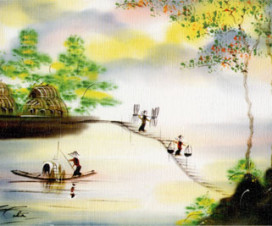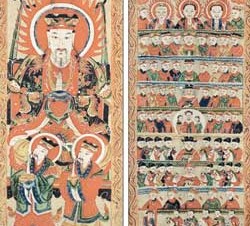The ancient village of Phuoc Tich in the central province of Thua Thien-Hue has been recognised as a national cultural heritage by the Government.
Phuoc Tich, located 40km to the north of Hue, has 117 old houses, including 27 in traditional style that are of invaluable architectural and cultural value.
Importantly, it has clung to its traditional pottery craft through the centuries.
The first villages sprung up in central Viet Nam centuries ago. During the Le dynasty in the late 15th century, especially during the reign of King Le Thanh Tong, great southward migrations were organised to extend the nation’s territory southward in the face of Chinese aggression in the north.
Later, in the mid-16th century, the Nguyen Lords, seeking to build a new royal capital in the south, set off a further migration that saw more villages mushroom in the central region.
Most of the migrants were farmers, and their foremost interest upon arrival at a new place was growing crops.
But some villages chose handicrafts and other vocations to make a living. Phuoc Tich was one such.
The founders decided to build the village in Con Duong, a sanctuary for local Cham villagers who were also the owners of the land.
The site was probably picked because it was ideal for the vocation the founders had chosen: pottery.
It was near a river, thus assuring a supply of vital water and enabling easy transport of raw materials and finished products.
Royal approval
Phuoc Tich was a famous pottery village in its heyday, supplying the entire central region. It achieved great honour when the Nguyen Court in Hue had the village produce “om ngu”, or clay pots for cooking in the Forbidden City.
Their success enabled Phuoc Tich residents to afford the renowned Hue-style traditional wooden houses that are now regarded as a cultural heritage of the village – 27 of them in an area of just 1.4sq.km, each nestling in a spacious garden.
Looking at these garden-houses now, visitors can easily picture in their mind’s eye the golden age of the village with its hustle and bustle, splendour, and prosperity.
Like in Hoi An, the village’s old structures have been preserved by a chance of history: Pottery-making gradually lost its charm and young people began to go to other places, leaving behind the old and very young, in search of jobs.
Those who stayed back had no reason to make changes to their homes, and a large number of them have survived intact.
These days the village is again receiving a lot of attention, this time from researchers in and outside the country. Its large assemblage of old traditional houses and vestiges of Cham culture convince them of its great cultural heritage.
The Government and foreign organisations are considering plans to revive the pottery art of Phuoc Tich and, to an extent, restore the vitality of this typical handicraft.
The most ambitious project is one envisaged by Belgium’s Wallonie Heritage Institute and the Viet Nam Institute of Culture and Arts to revive the village through a tourism-based project. It is expected to help research the cultural heritage of the village, preserve the old traditional houses, and revive the traditional handicraft by organising tours to the place based on pottery, holding a “Heritage Day” festival in the village, setting up a website for it, and exhibiting Phuoc Tich products in Belgium.
The project could benefit the village greatly but suffers from some drawbacks.
No paddy fields
Because of its traditional dependence on pottery, the village is one of those rare Vietnamese ones without rice paddies.
In the late 20th century, when plastic products appeared on the market, everyday pottery died out slowly.
Without rice fields to turn to unlike in most other villages, people, especially young ones, began to migrate to cities, leaving behind old people and children.
This is a reasonably common occurrence in Vietnamese villages but Phuoc Tich has taken it to an extreme: old people and children make up 80 per cent of its population.
The farm chores that give rise to the iconic images of rural Viet Nam and draw tourists are conspicuous by their absence here.
Last summer I visited Phuoc Tich with American woman Le Thi Ngoc Dieu, and her husband Daniel Mark, both university professors. We were disappointed despite being briefed about its present state.
The fields appeared withered and uncared for, the houses were deadly quiet with old people and children listlessly sitting on the doorstep, staring vacantly, and doing nothing.
We agreed that to make the village interesting for tourists, the first thing to do was to give it back its pastoral life.
Then, the planned revival of the pottery craft should be able to provide well-paid employment to persuade young people to return home.
Another issue is the value of the pottery they may produce. The craftspeople, no longer conversant with the demands of the market, should be thoroughly apprised on patterns and styles they should create.
Nguyen Huu Thong, president chairman of the Viet Nam Institute of Culture and Arts, said his agency plans to link up Phuoc Tich with two neighbouring villages – My Xuyen (famous for its carvings) and Phu Oc Dem (rush-weaving) – to make wooden statues with ceramic pedestals.
This is likely to add value to Phuoc Tich’s products and help bring young people from neighbouring villages before Phuoc Tich’s young return themselves.
It appears to be most viable project conceived yet to resuscitate the village.




